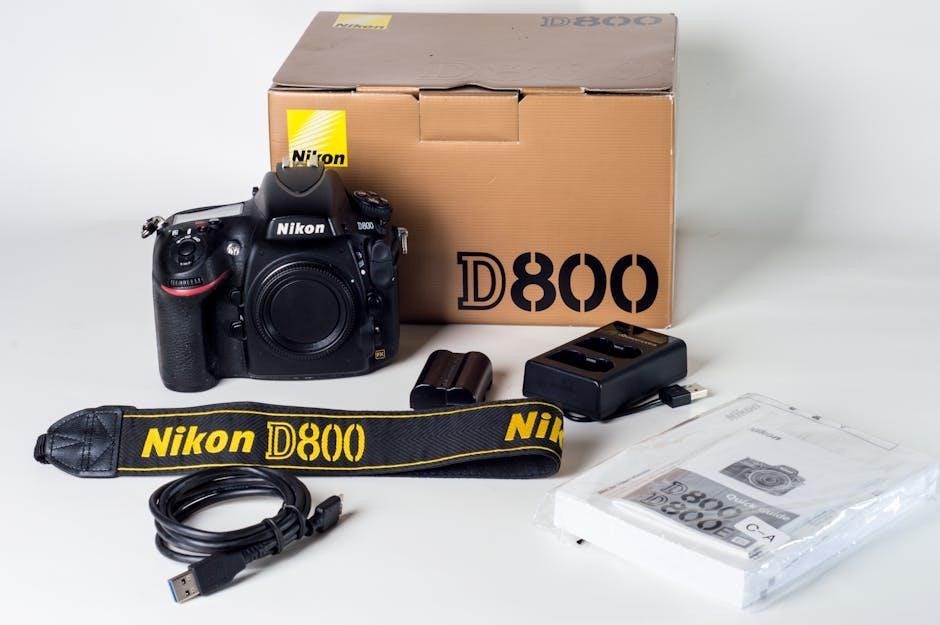Welcome to the Fluke 754 User Manual, your comprehensive guide to understanding and operating the Fluke 754 Documenting Process Calibrator. This manual provides detailed instructions, safety precautions, and troubleshooting tips to ensure optimal performance and accurate calibration. Discover how to leverage its advanced features, including HART communication and data logging, to streamline your workflow and maintain precision in industrial processes.
Overview of the Fluke 754 Documenting Process Calibrator
The Fluke 754 is a multifunctional documenting process calibrator designed for precision and efficiency in industrial environments. It supports pressure, temperature, and electrical measurements, while also offering advanced features like HART communication and data logging. This calibrator is ideal for troubleshooting, calibration, and documentation of process instruments. Its user-friendly interface and robust functionality make it a versatile tool for maintaining accuracy and streamlining workflows in various industries. The device is compatible with Fluke software, enhancing its capabilities for detailed data management and analysis.
Importance of the User Manual for Optimal Device Usage
The user manual is essential for maximizing the potential of the Fluke 754. It provides clear instructions on installation, operation, and troubleshooting, ensuring users can utilize all features effectively. The manual outlines safety guidelines, warranty details, and maintenance tips, helping to prevent errors and extend the device’s lifespan. By following the manual, users can optimize performance, ensure accuracy, and comply with industry standards. It serves as a comprehensive resource for both novice and experienced operators, fostering efficiency and reliability in their work.

Safety Precautions and Guidelines
Always follow safety guidelines to prevent hazards. Read the manual thoroughly, ensure proper handling, and adhere to precautions to maintain device integrity and user safety.
General Safety Information for Handling the Fluke 754
Always handle the Fluke 754 with care to avoid damage or injury. Ensure proper grounding and avoid exposure to extreme temperatures or humidity. Use only approved accessories and follow all safety icons in the manual. Store the device in a protective case when not in use. Regularly inspect cables and connectors for damage. Avoid overloading the device, and keep it away from flammable materials. Proper maintenance ensures accurate performance and longevity of the calibrator.
Understanding Safety Icons and Symbols in the Manual
The Fluke 754 manual uses safety icons to alert users to potential hazards. These symbols, such as a warning sign for high voltage or a caution indicator for hot surfaces, are crucial for safe operation. Understanding each icon ensures proper handling and prevents accidents. Always refer to the manual’s legend for icon meanings. Adhering to these warnings guarantees safe and effective use of the calibrator.
Standard Equipment and Accessories
The Fluke 754 package includes a USB communication cable, HART communication cable, soft carrying case, and a Quick Reference Guide. Additional accessories enhance functionality.
What’s Included in the Fluke 754 Package
The Fluke 754 package includes a USB communication cable, HART communication cable, soft field case, Quick Reference Guide, and a NIST-traceable calibration report. Batteries and a 3-year warranty are also provided. These accessories ensure seamless operation and troubleshooting, while the calibration report verifies device accuracy. The package is designed to support both field and laboratory use, offering everything needed to start calibrating and documenting processes efficiently.
Recommended Accessories for Enhanced Functionality
To maximize the potential of your Fluke 754, consider these recommended accessories: a additional USB communication cable, HART communication cable, or a soft field case for protection. Software like Fluke 750SW DPC/Track2 enhances data management. A high-capacity battery or external charger ensures uninterrupted operation. Optional calibration kits and adapters can expand compatibility with various devices. These accessories streamline workflows, improve portability, and enhance overall performance, making the Fluke 754 even more versatile for industrial calibration tasks.

Installation and Setup
The Fluke 754 setup involves unpacking, connecting, and configuring the device. Install the software, familiarize yourself with controls, and ensure all components are ready for field operations.
Initial Setup and Configuration of the Fluke 754
Begin by unpacking the Fluke 754 and inspecting all components. Connect the device to your PC using the provided USB cable and install the Fluke 750SW software. Power on the calibrator and follow on-screen prompts to complete the initial setup. Configure the device settings, including date, time, and unit preferences. Ensure the firmware is up-to-date by checking the Fluke website. Finally, calibrate the device according to the manual or software instructions to ensure accuracy and reliability.
Connecting the Fluke 754 to a PC
Connect the Fluke 754 to your PC using the provided USB communication cable. Ensure the device is powered on. Install the Fluke 750SW software from the official Fluke website to enable communication. Once connected, the PC will recognize the calibrator, allowing data transfer and configuration. For advanced features like HART communication, refer to the manual for additional setup instructions. Proper connection ensures seamless operation and accurate data management.
Preparing the Device for Field Use
Before using the Fluke 754 in the field, ensure the battery is fully charged and all necessary accessories are organized. Update the firmware to the latest version for optimal performance. Conduct a quick function test to verify all features are operational. Organize cables, connectors, and documentation in the provided case for easy access. Refer to the manual for specific pre-field checks to ensure accurate measurements and reliable operation during calibration tasks.

Calibration Procedures
The Fluke 754 supports precise calibration processes with automated procedures and HART mode capabilities, ensuring accurate measurements and efficient data documentation for industrial applications.
Step-by-Step Calibration Guide for the Fluke 754
Start by powering on the Fluke 754 and selecting the desired calibration mode. Use the touchscreen interface to choose the measurement type, such as pressure or temperature. Follow the on-screen instructions to connect the device to the instrument being calibrated. Perform a zero adjustment if necessary. Record the measured values and compare them to the expected readings. Adjust the instrument accordingly until the desired accuracy is achieved. Save the calibration data for documentation purposes. This process ensures precise and efficient calibration, leveraging the device’s advanced features for optimal results.
HART Mode Configuration and Calibration
To configure HART mode on the Fluke 754, select the HART communication option from the device menu. Connect the HART-compatible transmitter using the provided communication cable. Follow the on-screen instructions to establish communication and access transmitter configurations. Perform calibration by selecting the desired measurement parameters and adjusting the transmitter settings as needed. Ensure all values are within the acceptable range and document the calibration results for record-keeping. This process enables precise control and ensures compliance with industrial standards.
Documenting Calibration Results
The Fluke 754 simplifies the documentation of calibration results by automating data capture and storage. Once calibration is complete, the device generates detailed reports, including measured values, reference standards, and timestamps. These reports can be transferred to a PC via USB or wirelessly for further analysis and archiving. The 754 also supports compatibility with Fluke’s software solutions, enabling seamless integration of calibration data into your existing documentation and compliance systems for traceability and audit purposes.

Troubleshooting Common Issues
This section provides guidance on identifying and resolving common errors, interpreting error messages, and using diagnostic tools to restore optimal functionality of the Fluke 754 calibrator.
Identifying and Resolving Common Errors
Common errors with the Fluke 754 include incorrect calibration, communication issues, and sensor malfunctions. Check error messages for specific codes, such as “NIST-traceable calibration report” discrepancies.
– For calibration errors, ensure proper setup and zeroing procedures.
– For communication issues, verify HART settings and cable connections.
– For sensor problems, clean or replace the sensor if damaged.
Refer to the troubleshooting guide for detailed solutions. Regular updates and maintenance can prevent recurring issues, ensuring accurate and reliable performance.
Understanding Error Messages and Codes
The Fluke 754 displays specific error messages to indicate issues during operation. Codes like “NIST-traceable calibration report discrepancies” or “HART communication failures” provide clues about the problem. Refer to the manual’s troubleshooting section for code interpretations. Addressing errors promptly ensures accurate calibration and prevents data loss. Always consult the error log for detailed explanations and follow the recommended solutions to restore normal functionality. Regular updates and maintenance can minimize error occurrences.
Advanced Features of the Fluke 754
Explore the advanced capabilities of the Fluke 754, including HART communication, data logging, and advanced calibration techniques. These features streamline workflows and ensure precision in industrial processes.
Using the HART Communication Function
The Fluke 754’s HART communication function enables seamless interaction with HART-compatible devices, allowing users to configure, calibrate, and troubleshoot transmitters efficiently. This feature supports advanced diagnostic capabilities, ensuring accurate data transmission and device performance. By leveraging the HART interface, users can access detailed device information, perform remote calibrations, and streamline maintenance tasks, enhancing overall productivity in industrial environments.
Data Logging and Management
The Fluke 754 offers robust data logging and management capabilities, allowing users to record and store calibration data efficiently. This feature ensures accurate documentation of all measurements and procedures, enabling easy retrieval for reporting and compliance purposes. The device’s compatibility with software tools like Fluke 750SW DPC/Track2 simplifies data transfer and analysis, while its automated processes reduce errors and streamline workflows in industrial and process control environments.
Advanced Calibration Techniques
The Fluke 754 supports advanced calibration techniques, including custom calibration routines and automated documentation. Users can leverage HART mode for precise transmitter configuration and calibration. The device allows for simultaneous measurement of multiple parameters, enhancing efficiency in complex industrial environments. Advanced features also include the ability to upload specific calibration instructions via PC, ensuring tailored procedures for unique applications. These capabilities make the Fluke 754 an indispensable tool for professionals requiring high-precision and adaptable calibration solutions.

Maintenance and Care
Regularly clean the Fluke 754 with a soft cloth and store it in a protective case to prevent damage. Update firmware periodically for optimal performance and security.
Cleaning and Storing the Fluke 754
Regular cleaning ensures optimal performance. Use a soft, dry cloth to wipe the device, avoiding harsh chemicals. Store the Fluke 754 in a protective case to prevent damage. Keep it in a cool, dry environment, away from direct sunlight and extreme temperatures. Avoid exposing the device to moisture or dust. For prolonged storage, ensure all batteries are removed and the device is securely packed. Refer to the manual for detailed storage guidelines to maintain its accuracy and longevity.
Updating Firmware and Software
Regular firmware and software updates ensure the Fluke 754 operates with the latest features and improvements. Visit the official Fluke website to check for updates. Use the provided USB cable to connect the device to your PC and follow on-screen instructions. Always back up data before updating. Ensure the device is powered during updates to prevent interruptions. Refer to the manual for step-by-step guidance. Keeping the firmware current enhances performance, security, and compatibility with other systems.
Scheduling Regular Maintenance
Regular maintenance ensures the Fluke 754 remains accurate and reliable. Schedule calibration checks every six months or as required by your quality system. Inspect batteries and connections for wear. Clean the device per manual instructions. Update firmware and software periodically. Refer to the user manual for detailed maintenance procedures. Routine checks prevent unexpected downtime and ensure precise measurements. Maintain a record of all maintenance activities for compliance and tracking. Contact Fluke support for professional calibration services if needed.

Technical Specifications
The Fluke 754 is a multifunction documenting process calibrator, measuring pressure, temperature, and electrical signals with high accuracy. It supports HART communication and data logging, ensuring precise performance across industrial applications.
Performance Characteristics of the Fluke 754
The Fluke 754 is a multifunction documenting process calibrator designed for high-precision measurement of pressure, temperature, and electrical signals. It offers advanced features like HART communication and data logging, enabling accurate and efficient calibration processes. With its robust design, the device ensures reliability in demanding industrial environments. The Fluke 754 supports a wide range of measurement parameters, making it versatile for various applications. Its performance is backed by Fluke’s commitment to quality, ensuring superior accuracy and durability for field use.
Compatibility with Other Devices and Software
The Fluke 754 is designed to integrate seamlessly with a variety of devices and software, enhancing its functionality. It supports HART communication, allowing connection to HART-enabled transmitters for advanced calibration and data exchange. The calibrator is compatible with Fluke’s 750SW DPC/Track2 software and third-party programs like Cornerstone, enabling detailed data logging and analysis. Additionally, it connects to PCs via USB for easy data transfer and software updates, ensuring compatibility with modern industrial systems and workflows. This versatility makes the Fluke 754 a versatile tool for diverse applications.

Warranty and Support
The Fluke 754 is backed by a 3-year limited warranty covering defects in material and workmanship. Support is available through Fluke’s authorized resellers and service centers.
Understanding the Fluke Warranty Policy
The Fluke 754 warranty ensures your device is free from material and workmanship defects for three years from purchase. This coverage extends to the original buyer or end-user, excluding consumables like batteries. Repairs or replacements are provided at no cost during this period. For detailed terms, refer to the warranty section in the user manual or contact Fluke support directly. This policy underscores Fluke’s commitment to quality and customer satisfaction.
Contacting Fluke Support and Service Centers
To contact Fluke support, call 1.888.610.7664 or visit their website for additional resources. Fluke’s support team is available to assist with technical inquiries, repairs, and troubleshooting. For more information, refer to the contact details provided in the user manual or visit authorized service centers. Fluke’s dedicated support ensures prompt resolution of issues, helping you maintain optimal device performance and extend its lifespan.
Getting Started with the Fluke 754
Unpack, power on, and navigate the intuitive interface to begin using the Fluke 754. Follow the quick setup guide to start calibrating effortlessly.
Beginner’s Guide to Operating the Fluke 754
Start by unpacking and powering on the Fluke 754. Familiarize yourself with the interface, controls, and display. Follow the quick reference guide for initial setup, including date, time, and unit selection. Understand basic calibration functions and navigation. Practice with a simple calibration task to build confidence. Refer to the manual for detailed step-by-step instructions and troubleshooting tips. This guide ensures a smooth learning curve for optimal device operation.
Navigating the Device Interface
The Fluke 754 features an intuitive interface designed for ease of use. The high-resolution display provides clear visibility of measurements and menus. Use the navigation buttons to scroll through options, and the soft keys to select functions. The home screen offers quick access to core functions like calibration and measurement modes. Familiarize yourself with icons and symbols using the quick reference guide. Logical menu grouping ensures efficient operation, with visual feedback for selections and status updates. Mastering the interface enhances productivity and accuracy in daily tasks.

Resources for Further Learning
Fluke offers extensive resources, including online tutorials, training materials, and detailed documentation. Visit the official Fluke website for guides, manuals, and troubleshooting tips to enhance your expertise with the Fluke 754;
Additional Documentation and Manuals
The Fluke 754 is supported by comprehensive documentation, including the Users Manual, which covers installation, operation, and troubleshooting. Supplementary guides like the HART Mode Configuration Manual and Calibration Procedures Guide provide in-depth instructions for advanced features. Visit the official Fluke website to download these resources, ensuring you have all the necessary tools to maximize the device’s functionality. These materials are designed to enhance your understanding and optimize the performance of the Fluke 754.
Online Tutorials and Training Materials
Fluke offers a variety of online tutorials and training materials to help users master the Fluke 754. Visit the official Fluke website to access step-by-step guides, instructional videos, and interactive modules. These resources cover topics like HART communication, calibration procedures, and data logging. Additionally, the site provides downloadable PDF guides, such as the HART Mode User Guide and Calibration Tutorials, ensuring users can enhance their skills at their own pace. These materials are designed to support both beginners and advanced users.
Fluke provides extensive online resources, including tutorials and training materials, to help users optimize the Fluke 754. Visit the official Fluke website for step-by-step guides, instructional videos, and interactive modules. These materials cover calibration procedures, HART communication, and advanced features. Additionally, downloadable PDF guides, such as the HART Mode User Guide and Calibration Tutorials, are available to enhance your expertise. These tools cater to both beginners and experienced professionals, ensuring comprehensive understanding and mastery of the device.
The Fluke 754 offers advanced calibration, HART communication, and data logging, ensuring precise and efficient measurements. Its intuitive interface and robust features streamline workflows, while compatibility with various devices and software enhances versatility. The device supports both analog and digital instruments, making it ideal for industrial applications. With a 3-year warranty, the Fluke 754 provides reliability and durability, backed by Fluke’s commitment to quality and customer support. This calibrator is a trusted tool for professionals seeking accuracy and ease of use;
Final Tips for Maximizing the Use of the Fluke 754
To maximize the Fluke 754’s potential, regularly update its firmware and software for enhanced functionality. Explore advanced features like data logging and HART communication to streamline workflows. Schedule routine maintenance and cleaning to ensure accuracy and longevity. Utilize the provided accessories and compatibility options to integrate the device seamlessly into your setup. Refer to the user manual for troubleshooting and optimize calibration processes for precise results, ensuring reliable performance in industrial environments.

About Fluke Corporation
Fluke Corporation is a global leader in precision instrumentation, offering high-quality tools for measurement, calibration, and troubleshooting. Committed to innovation, they provide reliable solutions across industries.
Overview of Fluke and Its Commitment to Quality
Fluke Corporation, a trusted leader in precision instrumentation, has consistently delivered high-quality tools for measurement, calibration, and troubleshooting. With a strong commitment to innovation and reliability, Fluke ensures its products meet stringent standards, providing accurate and durable solutions. Their dedication to quality is evident in the Fluke 754, designed to enhance efficiency and accuracy in industrial processes, reflecting Fluke’s mission to empower professionals with exceptional tools for precise results.
Other Products and Solutions Offered by Fluke
Fluke offers a wide range of precision instruments and solutions beyond the 754, including digital multimeters, thermal imaging cameras, and network testers. Their product portfolio serves industries like electrical, industrial, and telecommunications. Fluke also provides advanced software tools for data analysis and management, enhancing workflow efficiency. With a focus on innovation and reliability, Fluke ensures professionals have the tools needed for accurate measurements and troubleshooting across various applications, maintaining their reputation as a leader in test and measurement technology.




